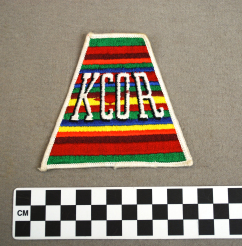This object is a patch from the KCOR AM radio and TV station. The KCOR radio station was founded in 1946 by Raoul Cortez. It was the first Spanish-language radio station in the United States. It was followed by the KCOR-TV station in 1955 which was also the first Spanish-language TV station. The television station was later bought out and renamed KWEX and became the first member of the Spanish International Network, which is now known as Univision. Spanish-language programs continue today and are extremely successful.
Raoul Cortez was born in Xalapa, Veracruz, Mexico in 1905. Because his father owned a radio station, Cortez grew up around the radio business. Following the outbreak of the Mexican Revolution, his family migrated to San Antonio, Texas. There, Cortez became involved in a Spanish-language newspaper called La Prensa. Much of his early career involved finding and carving out a space for Hispanic music and culture, in a time when very little was available for minorities. After feeling unsatisfied with the small time slots given to Mexican musicians on predominantly English channels, Cortez set out to start his own station in the 1940s. Even though there were Spanish-speaking immigrants living in the United States before this, Hispanic entertainment on the radio, and later television, was hard to find. After World War II, which saw many immigrant families serve on both the war and home fronts, the United States began to embrace more of its multicultural society.
Having a radio and television station in Spanish was of great importance. With many immigrants from Mexico and other Spanish speaking countries, the United States was gaining more diversity without changing much in its dominantly white society. Raoul Cortez’s push to start a station that used the Spanish language, which is a direct connection to Hispanic culture, gave Hispanics in the United States something they could relate to more easily than the many English media sources available. It opened up the way to a more diverse entertainment industry where Hispanic media continues to thrive.
Today, media like the radio and television play big roles in our day-to-day lives. Hispanic media continues to play an important role as a big business in the United States today. In fact, in 2013 the U.S. growth in English media spending was significantly lower than that of Hispanic media growth. Today, Univision and Telemundo are the two main companies involved in Spanish-language broadcasting. Novelas and “Sabado Gigante” are some of the most popular programs. Cortez and those involved in the KCOR’s founding were pioneers in promoting Hispanic media in the US.
